MARVELLOUS M5
On board M5, the largest single-masted sailing yacht in the world
A massive sailing yacht refit for an aviator with a need for speed - Marilyn Mower discovers a project that combines pragmatism and ambition in perfect measure that came to create M5.
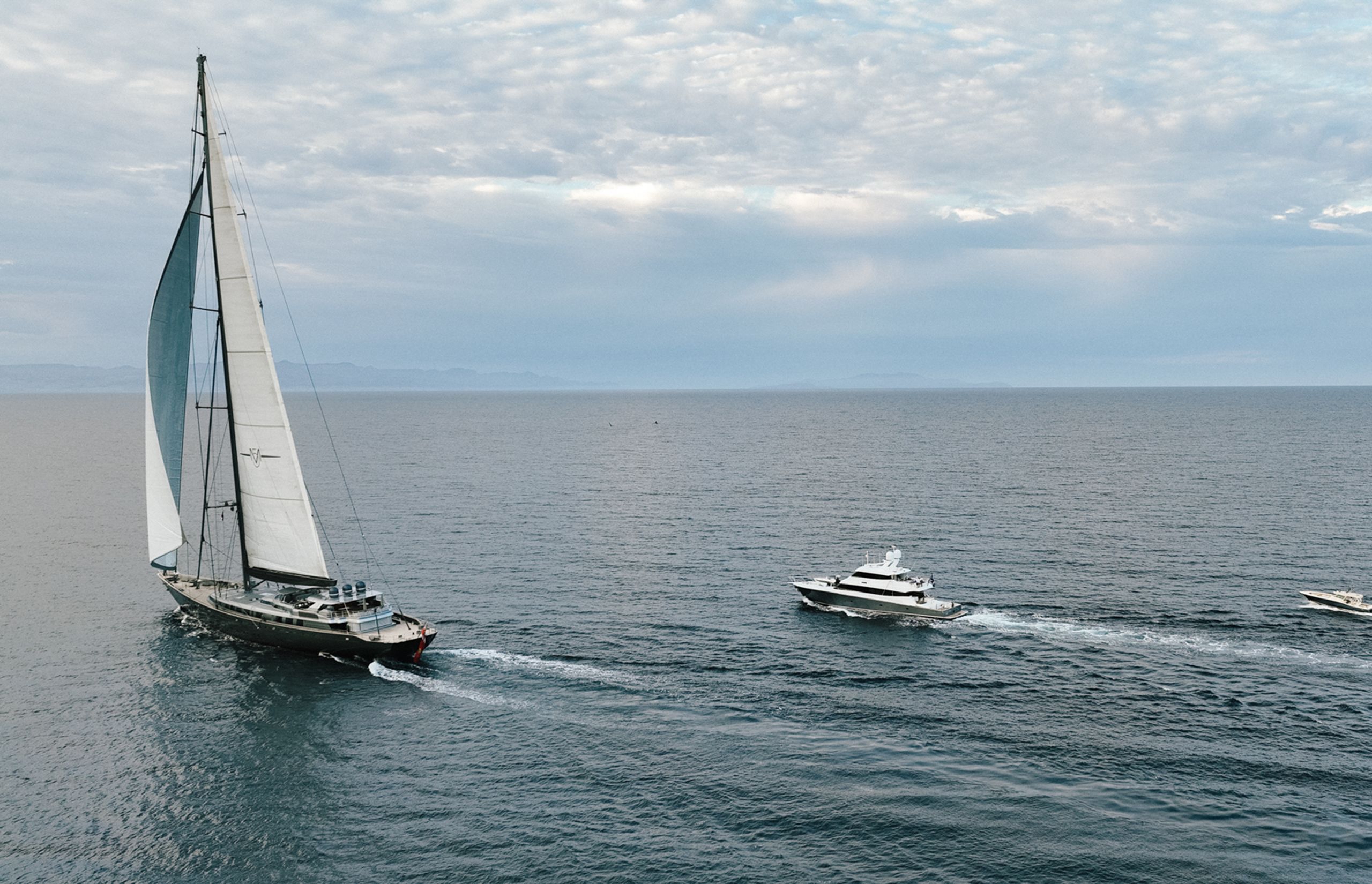
At 75 metres, Rod Lewis initially dismissed Mirabella V (now M5) as too much boat. A dozen years ago, the Texan owner was looking to build a composite sailing yacht of around 60 metres and had been developing ideas with naval architect Ron Holland. As Lewis had already chartered 64-metre Felicita West, Holland suggested he refine his wish list by looking at two more of his designs – the 2004 Mirabella V and the recently launched 56-metre Salute – and maybe even purchase one as an interim yacht.
Mirabella V was a bigger boat than he was looking for, but when he learned just how few builders would even discuss a 60-metre-plus composite sailing yacht, he took another look. While it needed modifications, he knew the boat’s owner, Joe Vittoria, and in 2011 negotiated a deal, renaming the yacht M5. Although he’s a serial sportfisher owner, this was a big step for someone whose previous sailing boat ownership consisted of a Sunfish and a Prindle Cat. Lewis, son of a US Air Force pilot, is better known as a collector of vintage warbirds, which at last count numbered 35.
“His first love is flying,” according to M5’s co-captain Don Anderson. “He finds a lot of similarities between sailing and flying.”
“I’ve got a need for speed. I’ve had M5’s helm at 22 knots; that’s my fastest. It’s kind of like flying on water”
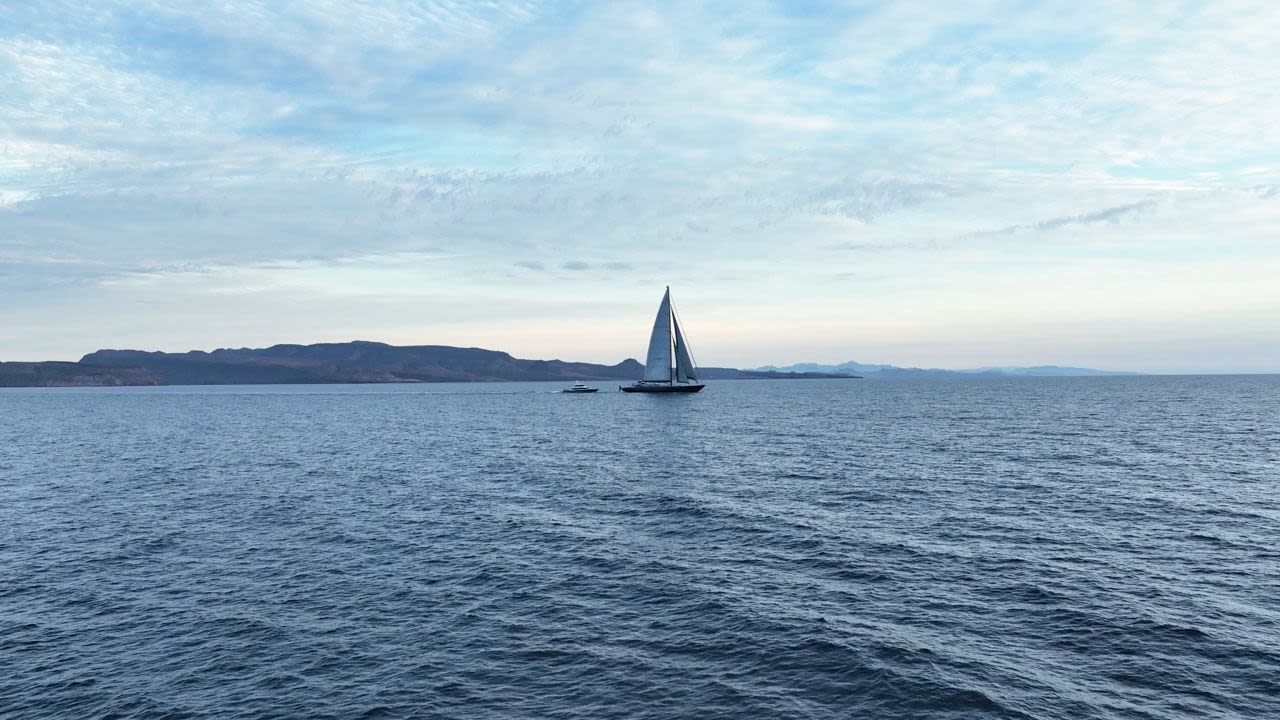
“That’s true,” says Lewis. He flies everything from helicopters to float planes to multi-engine jets to get from his home base in San Antonio to his work in south Texas. “I’m probably flying a helicopter three days a week and a plane five.” He’s also rated to fly almost every kind of Second World War aircraft, plus more modern fighter jets and trainers, and he flies them all regularly, including a CF-5D Freedom Fighter that approaches Mach 1.3.
“I’ve got a need for speed,” Lewis offers. “I’ve had M5’s helm at 22 knots; that’s my fastest. It’s kind of like flying on water.”
In the energy business where he made his fortune, Lewis is known as a “wildcatter”, someone who sinks oil or gas wells on speculation, often armed with only geology reports and a hunch. It’s fascinating, then, to hear of the measured approach he took to M5 by sailing the boat with his family for a year while learning about her pros and cons. A first refit accomplished between 2013 and 2014 at Pendennis saw major modifications including a stern extension, repowering, switching to Carbo-Link carbon fibre and titanium rigging for the world’s tallest mast (saving nearly 18 tonnes aloft), cutting the bulb off the keel to reduce weight below, adding a bimini top and gutting the interior, replacing it with one designed by RWD. These were overseen by Holland and his former employee Rob Doyle, who had established his own studio in Ireland after Holland relocated to Canada.
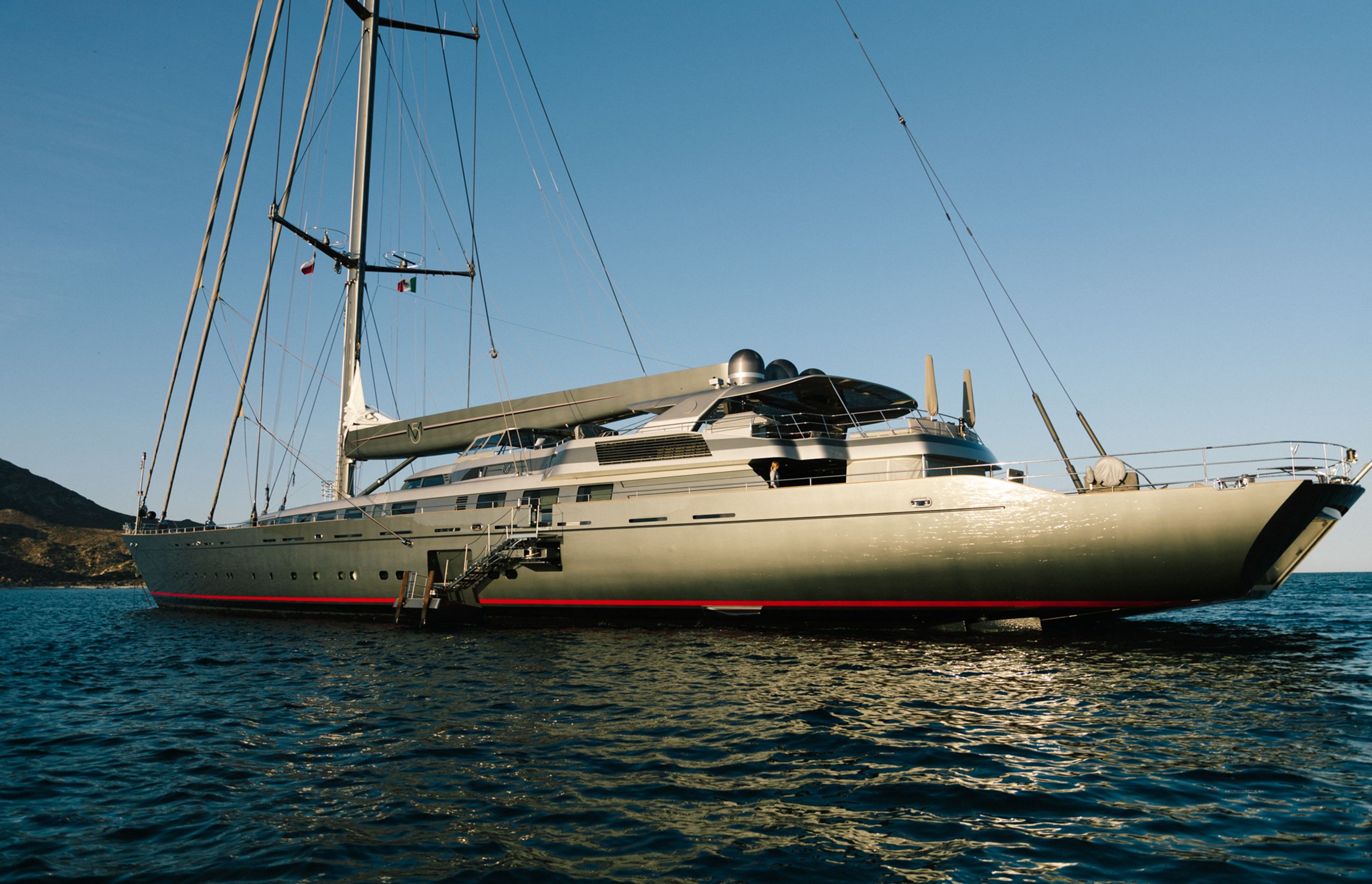
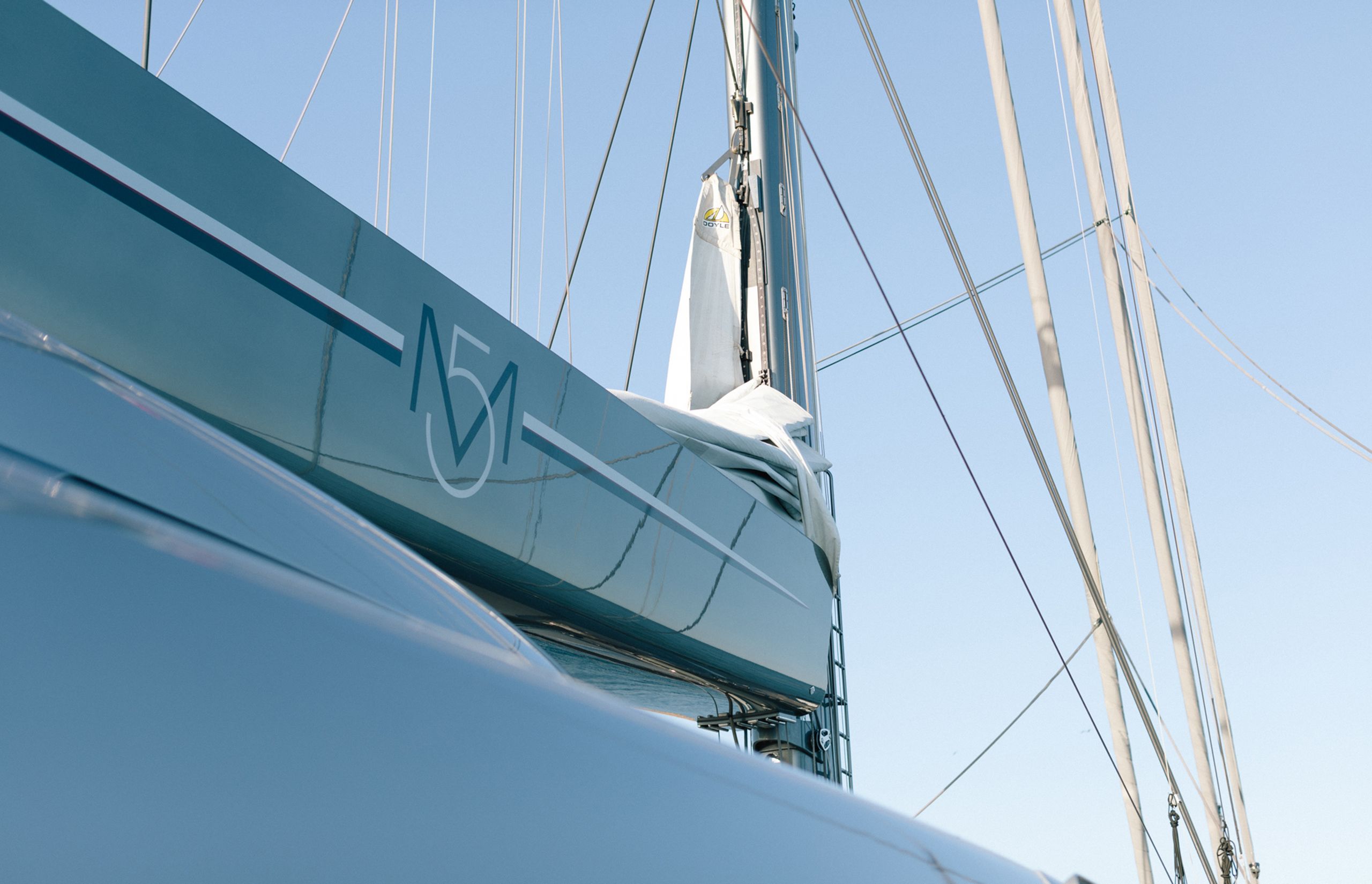
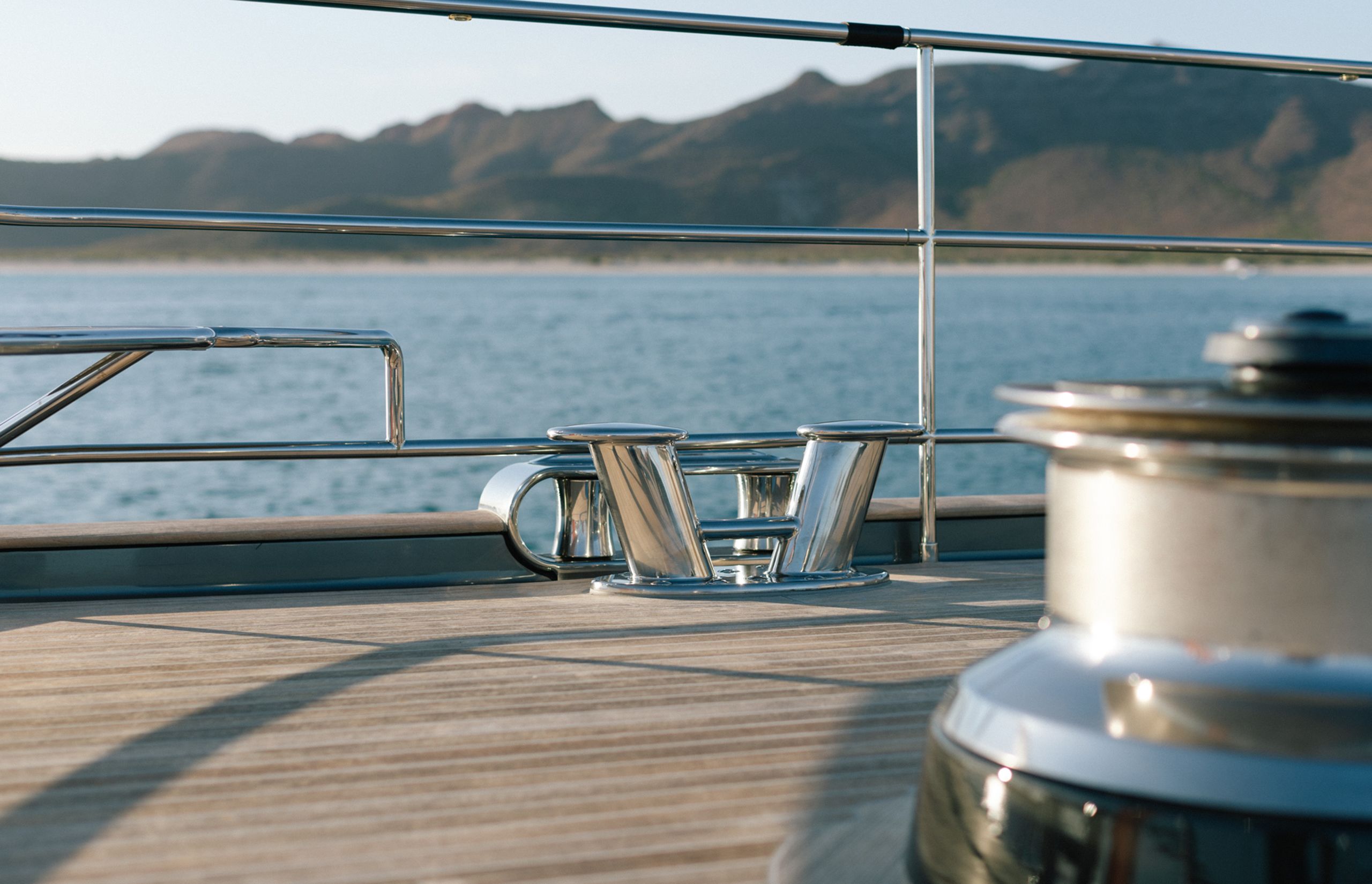
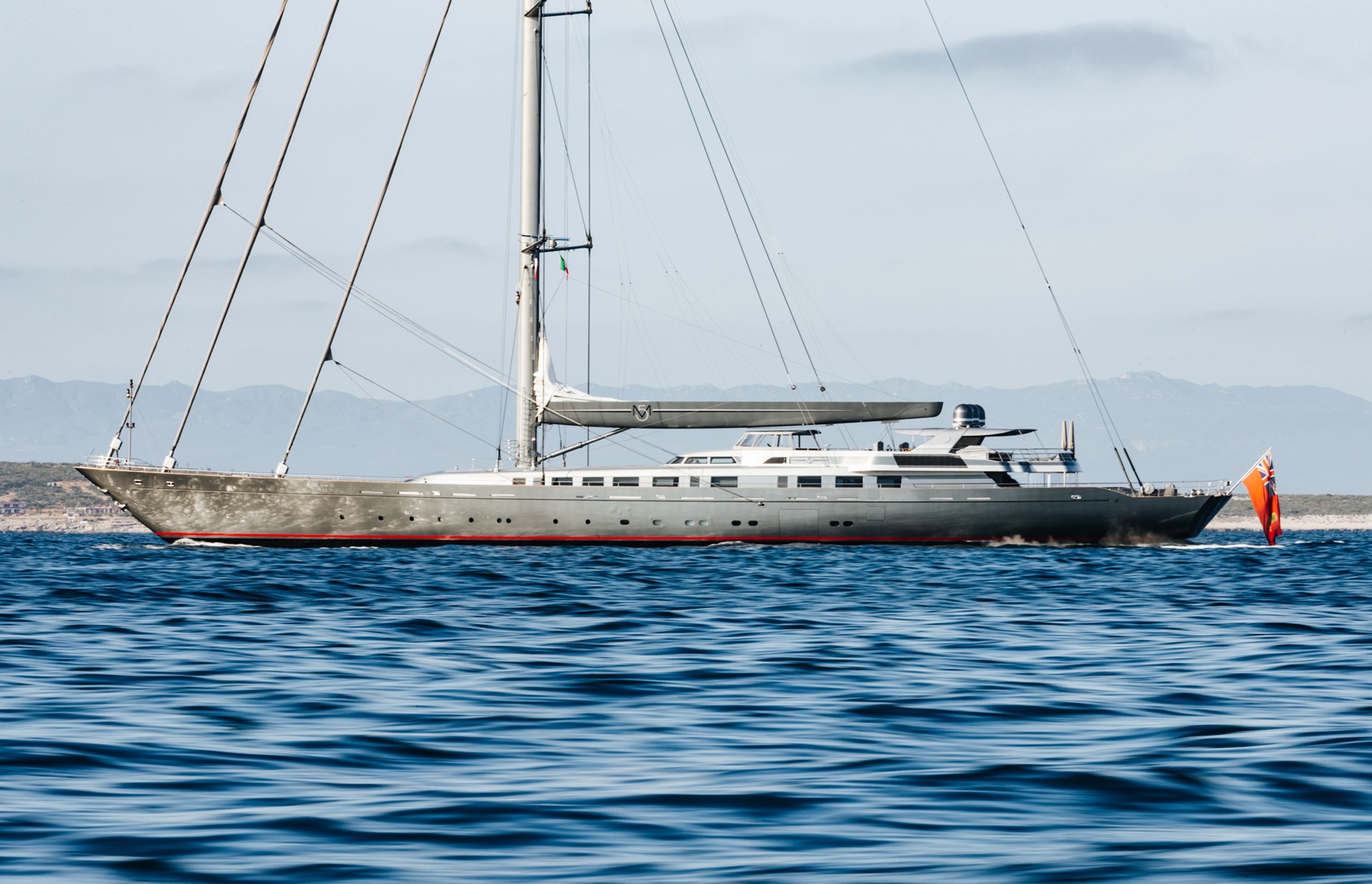
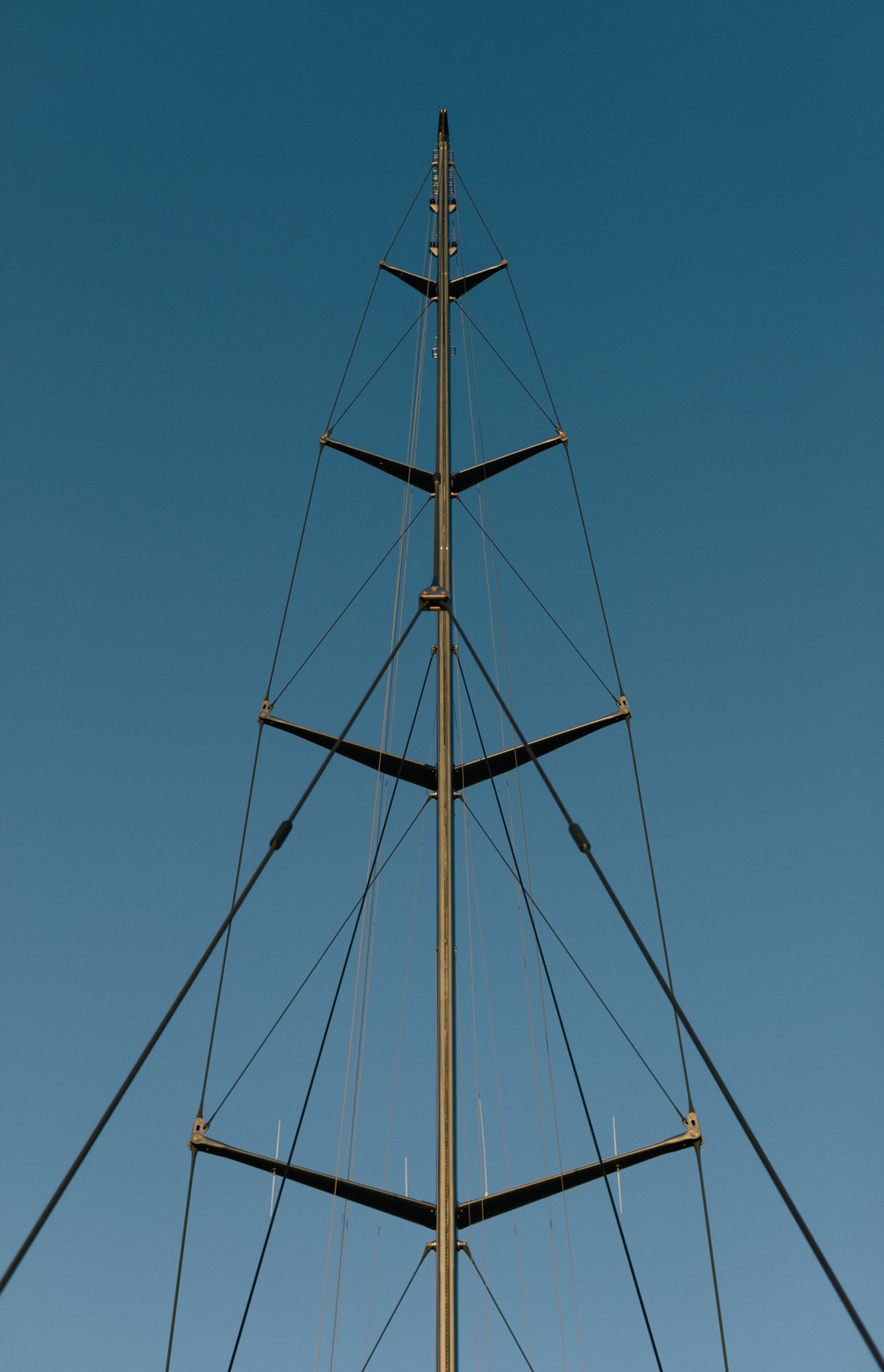

BRADLEY WENTZEL
BRADLEY WENTZEL

BRADLEY WENTZEL
BRADLEY WENTZEL

BRADLEY WENTZEL
BRADLEY WENTZEL

BRADLEY WENTZEL
BRADLEY WENTZEL

BRADLEY WENTZEL
BRADLEY WENTZEL
M5’s latest refit, begun in 2019 and completed in the spring of 2020, involved nearly two years in patient planning, according to Anderson. Two of the big-ticket items were changing the hull and superstructure colour and replacing the fabric and stainless steel biminis with composite structures. The other major work would be five-year survey items, reinforcing the mast, increasing the brute force of the bow thruster and solving a problem that arose because of slashing a 60-tonne chunk of lead ballast off M5’s keel in 2013.
“When we cut the trailing bulb off the keel [because the lighter rig required less ballast for a safe righting moment], it changed the pivot point on the lifting mechanism,” says Doyle. This imbalance caused the 96-tonne keel to scrape along the forward edge of the keel box. “It was [like] screaming cats for 11 minutes and the keel box is right next to the owner’s bed.”
“After the last refit, it was practically a brand new boat and I appreciated that. But it still wasn’t the boat I wanted. It needed to be tweaked”
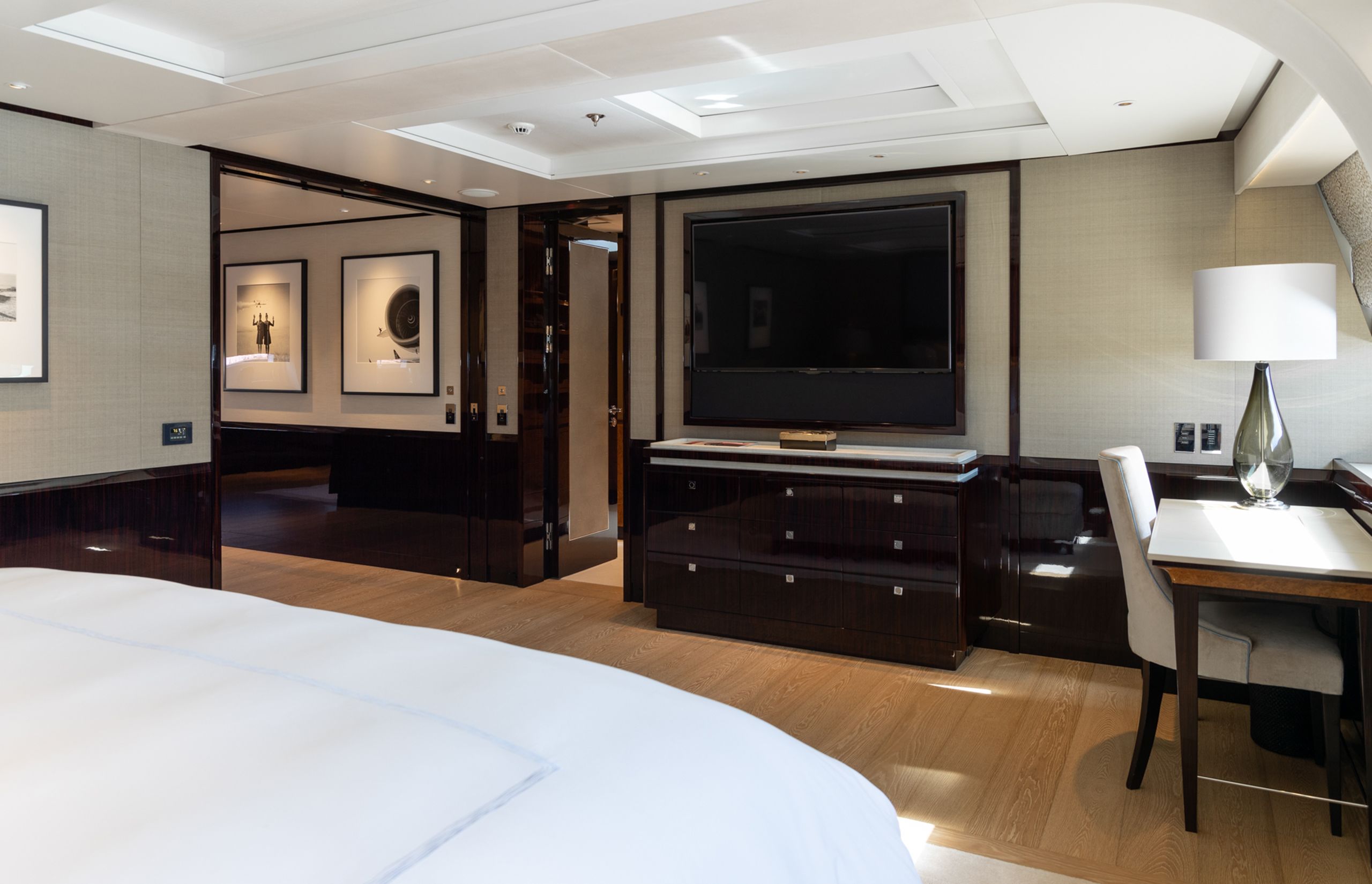
“It wasn’t just the noise,” says Anderson. “The whole boat was doing the Watusi as the keel would bind and then release over and over.” The issue wasn’t discovered until M5 relaunched at Pendennis and underwent sailing trials. By that time, winter was closing in and there wasn’t time to study and re-engineer the situation without losing another season. With the new rig and overall stability a success, it was deemed safe to defer rebalancing the keel. Lewis and his crew went out and sailed the boat hard, including a lap around the globe, and raced in the 2015 St Barths Bucket Regatta.
“We had put fibre optic sensors in the mast, and we realised the column was getting a lot of pressure at the spreaders and was in need of extra carbon fibre strengthening at these points,” says co-captain Ryan Bergman.
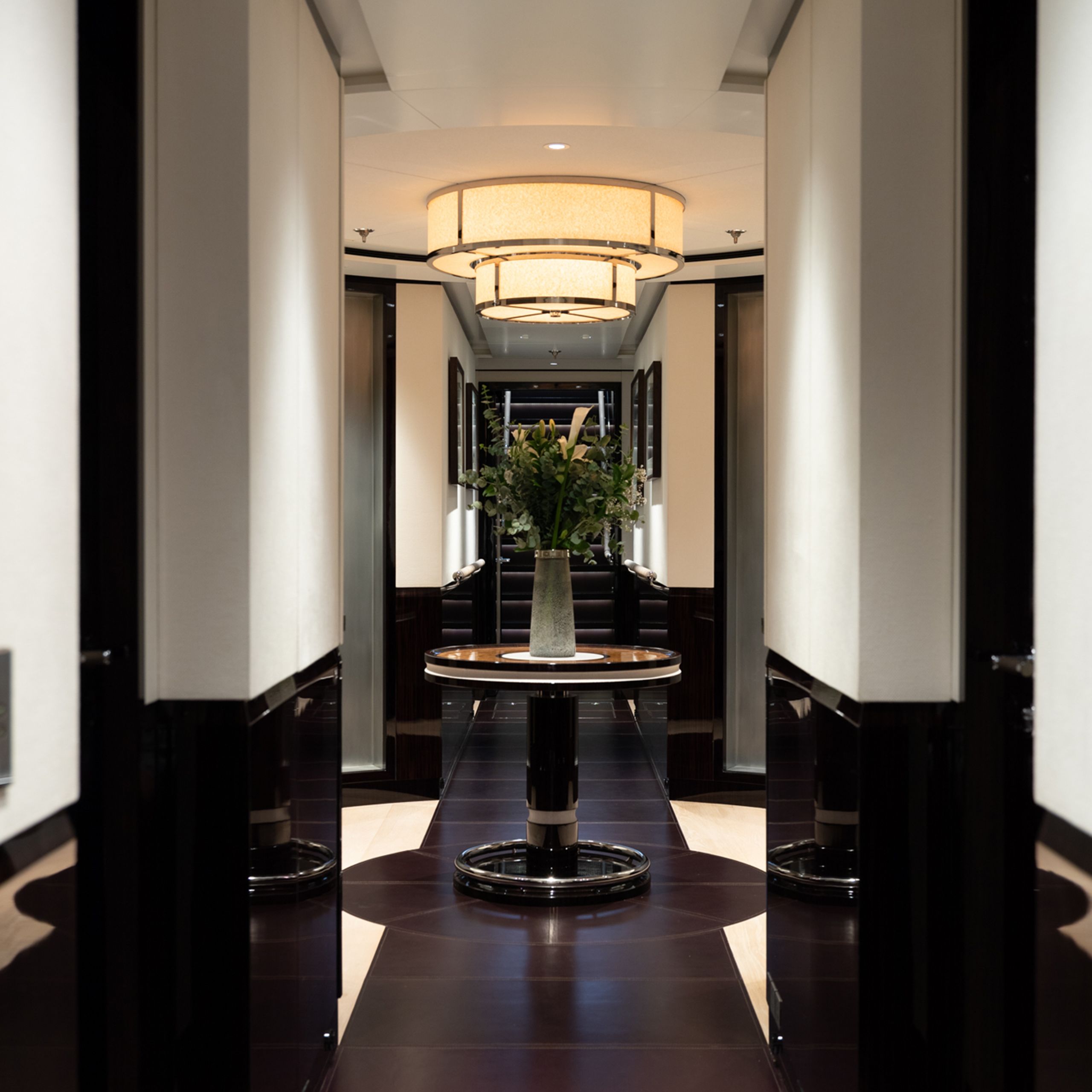
BRADLEY WENTZEL
BRADLEY WENTZEL
The interior has an on-trend high-contrast scheme forged of old and new pieces, new stone and a nod to art deco in the hardware
Anderson adds: “We began planning a refit in conjunction with the next big survey and began interviewing yards at METS [Marine Equipment Trade Show] in 2017.” After much research, NCA in Italy’s Carrara region was selected as the yard. Marine Results, a British firm that’s been involved with the yacht’s mast and rigging since day one, would supervise pulling, ultrasounding and repairing the mast on location.
The work list increased as Lewis discussed the project with the yard. For one thing, when he bought Mirabella V, there were no biminis or awnings in the flybridge. “Our owner likes to sail the boat and he discovered how hot the sun can be when sailing downwind with no shade,” Bergman says. The 2013 solution was to erect a frame and cover it in canvas.
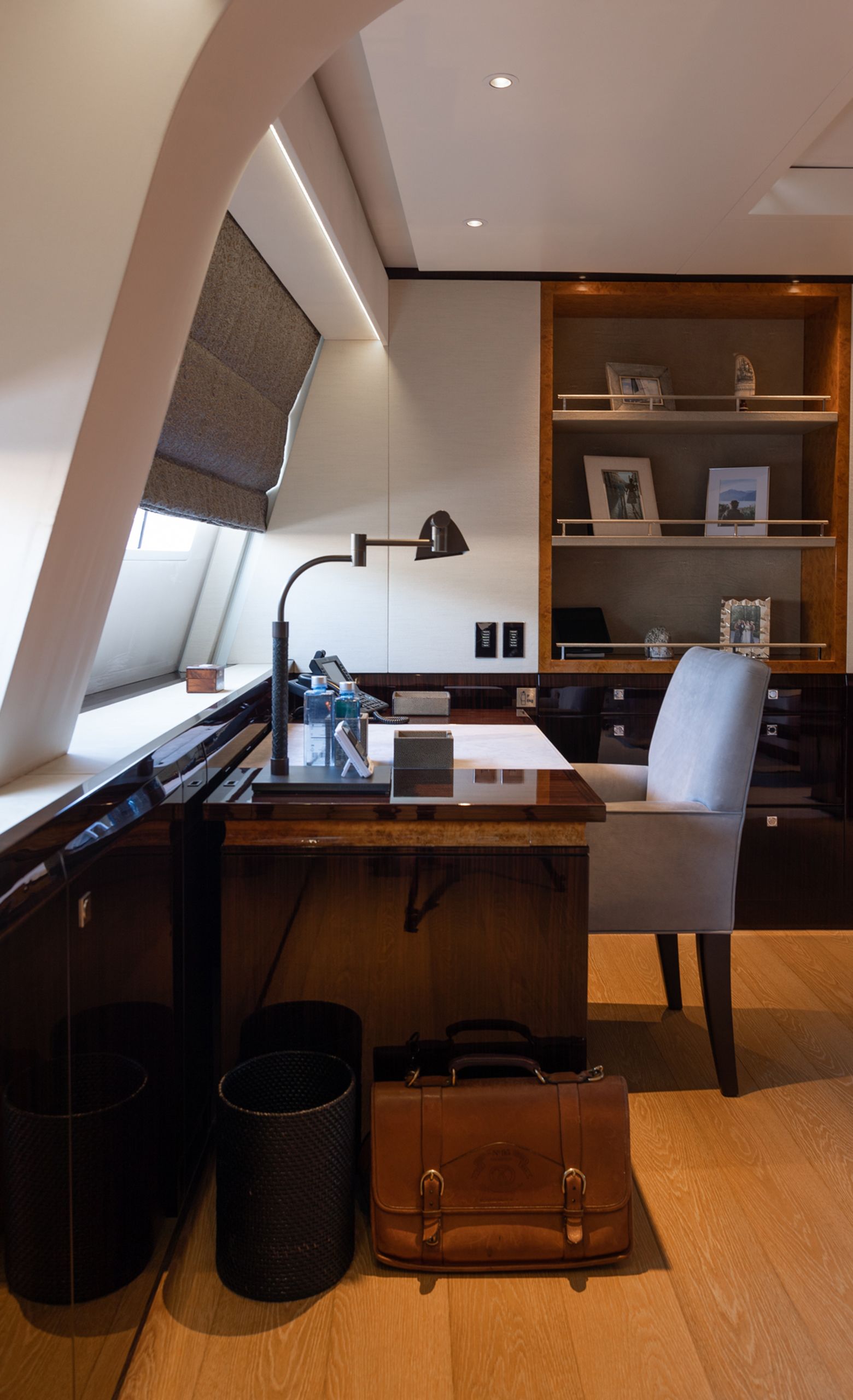
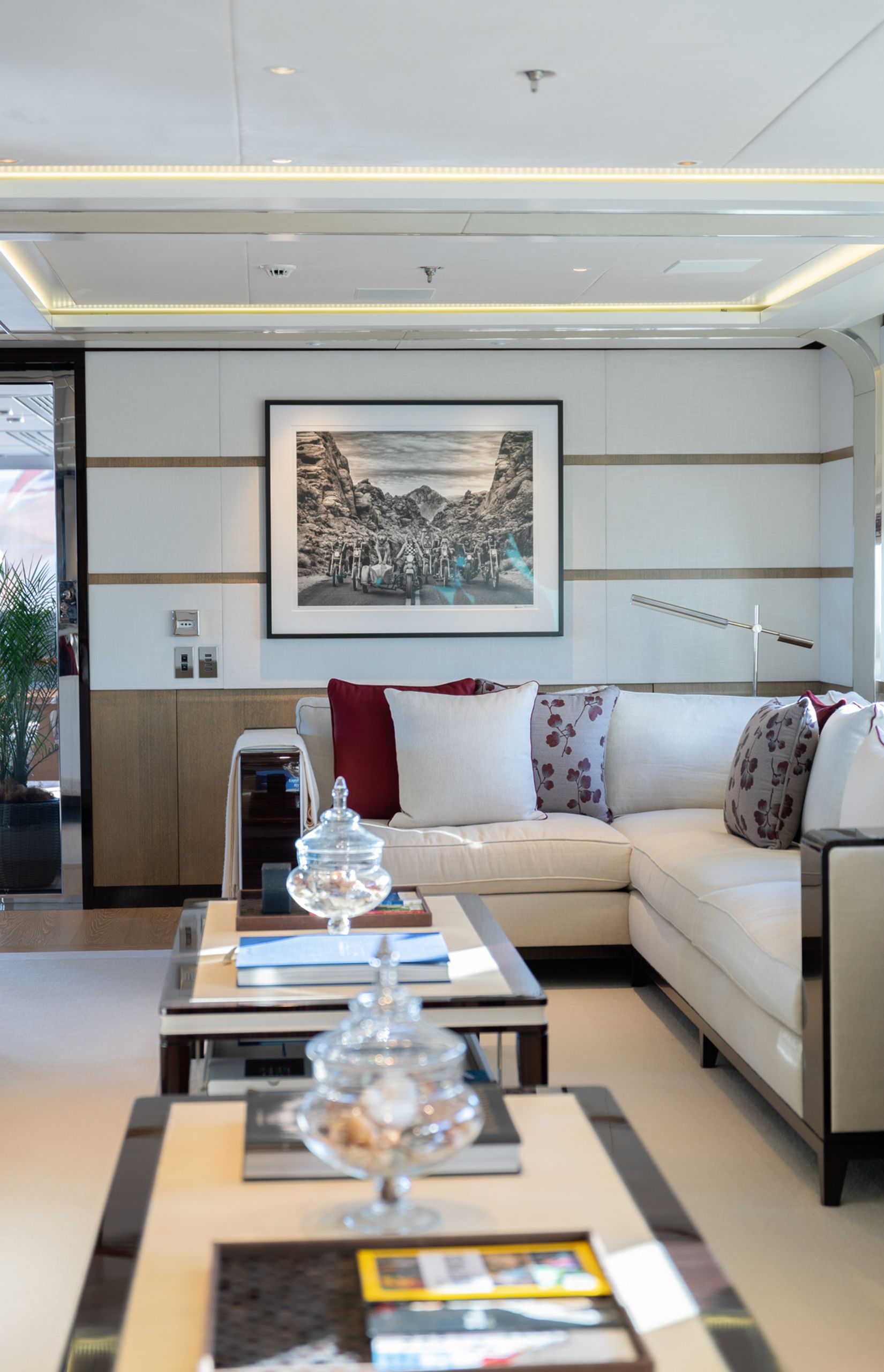
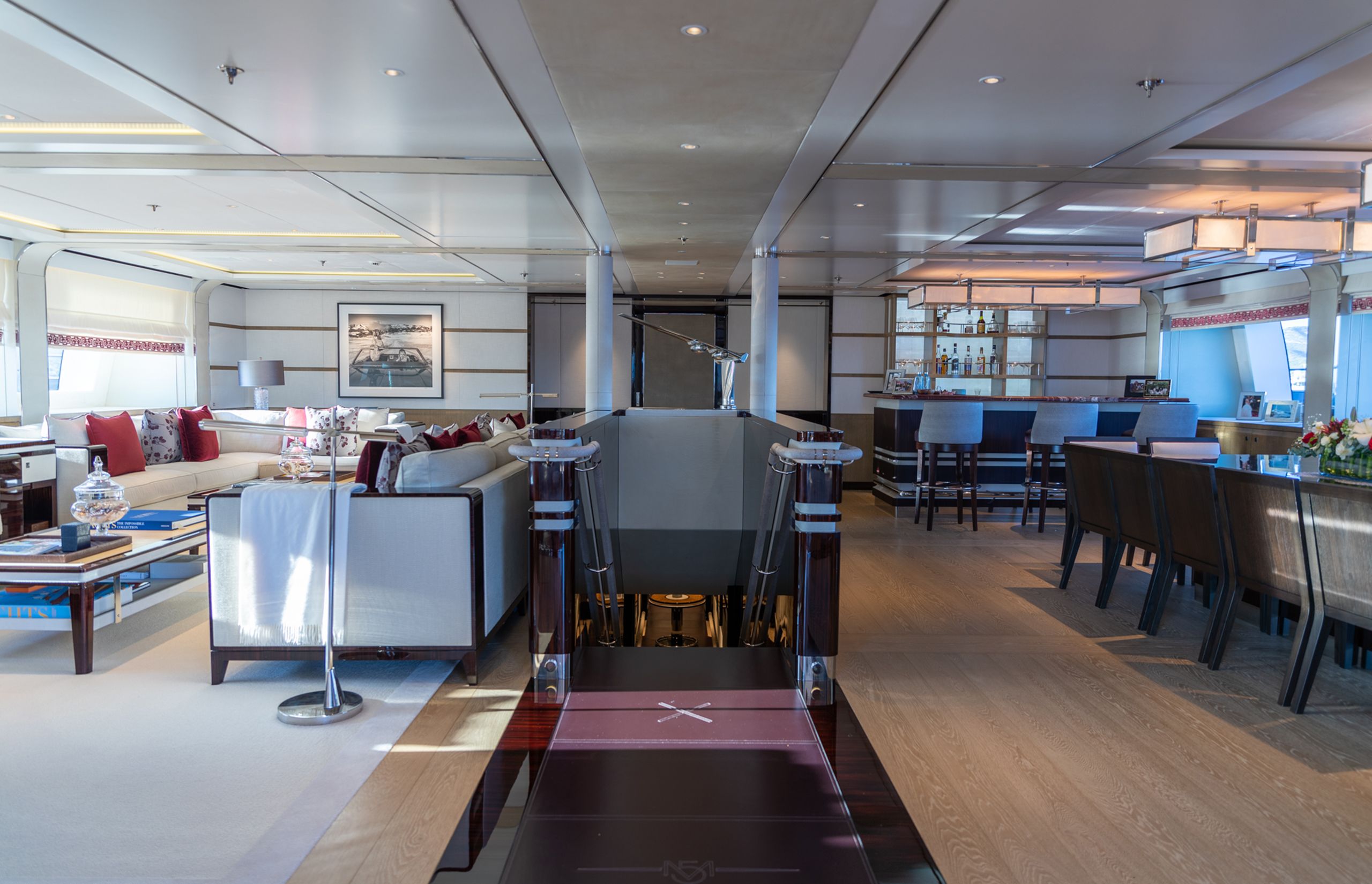
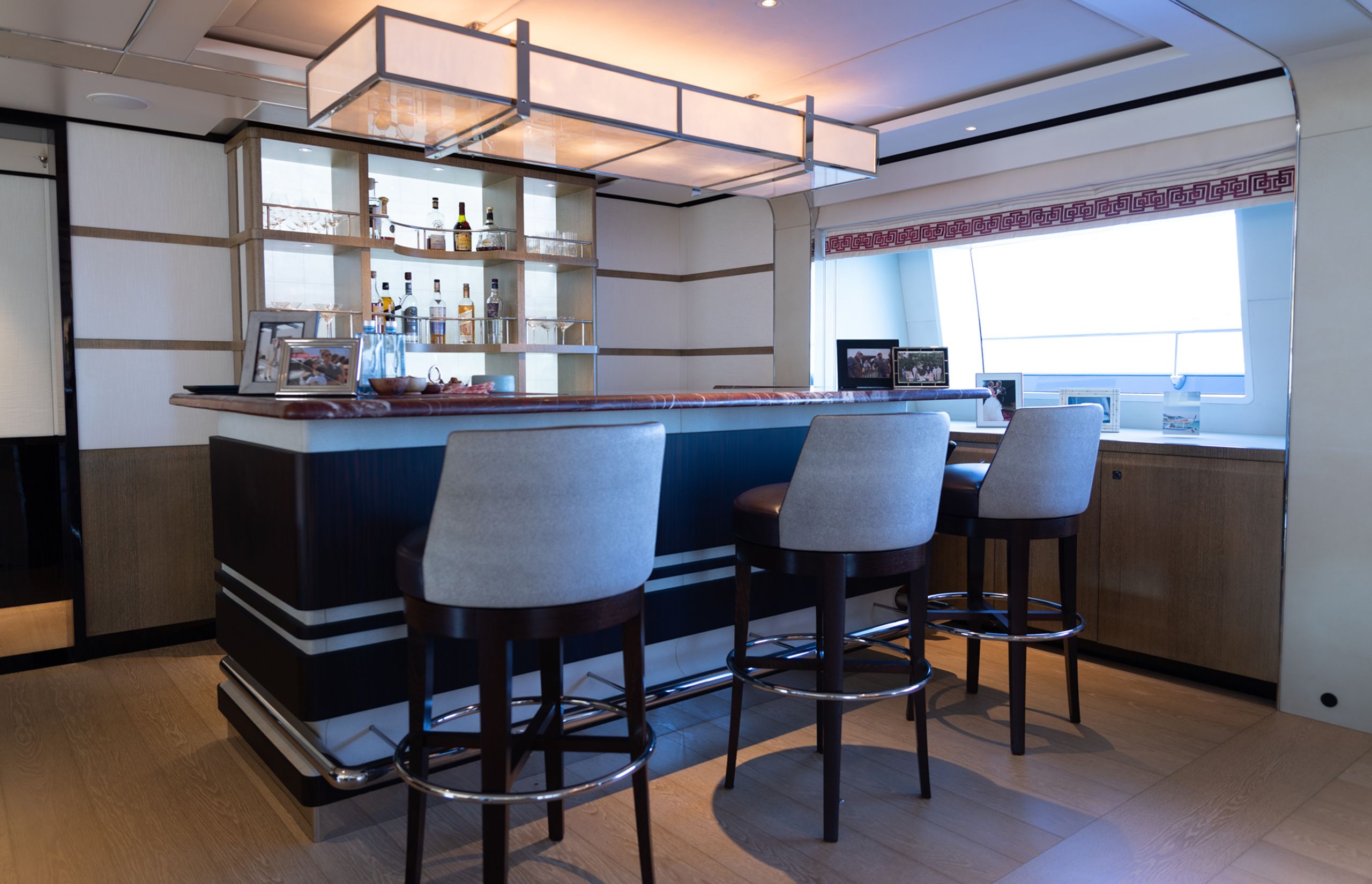
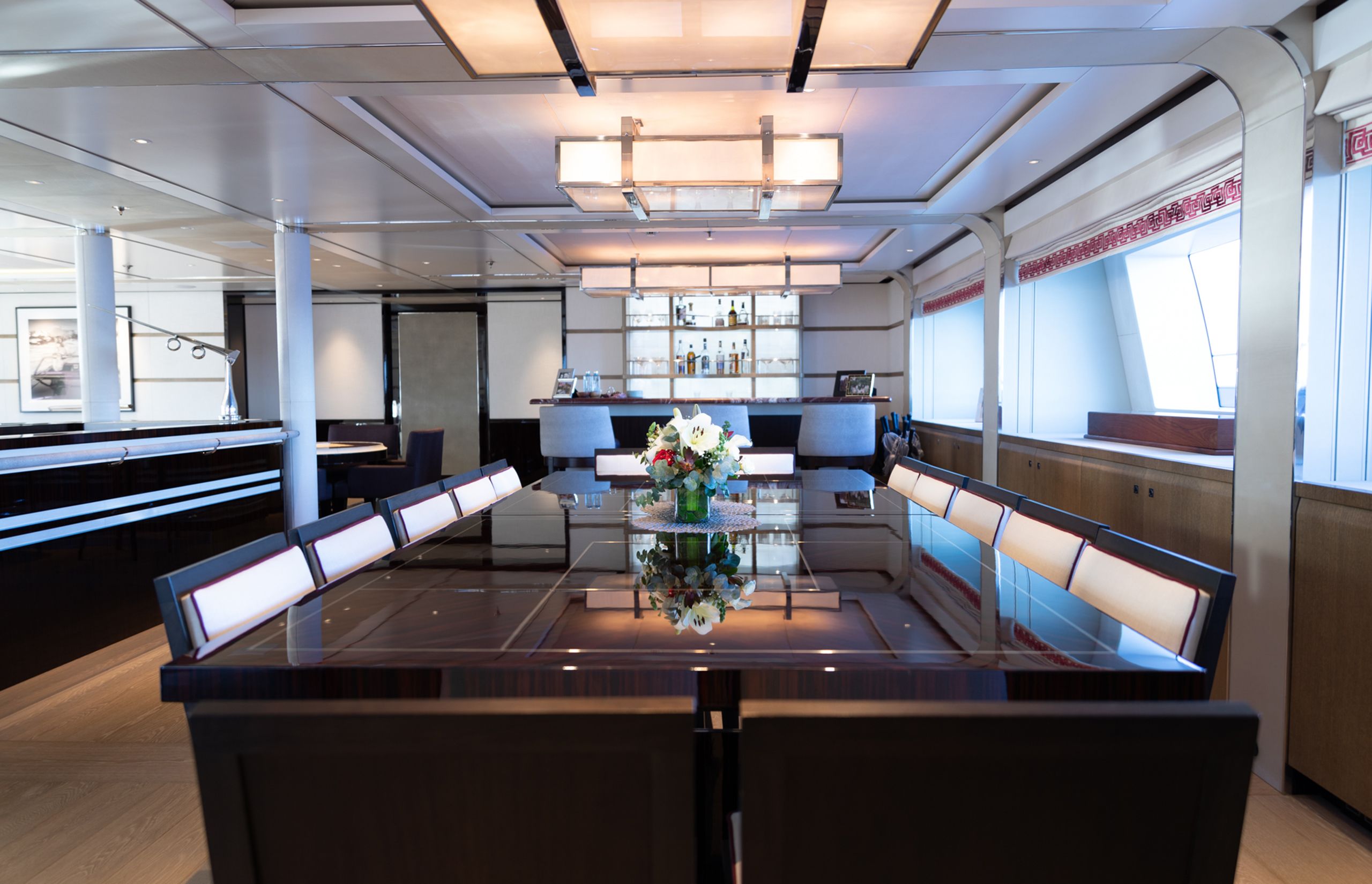

BRADLEY WENTZEL
BRADLEY WENTZEL

BRADLEY WENTZEL
BRADLEY WENTZEL

BRADLEY WENTZEL
BRADLEY WENTZEL

BRADLEY WENTZEL
BRADLEY WENTZEL

BRADLEY WENTZEL
BRADLEY WENTZEL
The stairs to the guest accommodation (top left) divide the starboard side dining table and bar (bottom left) from the saloon. With her 14.8m beam the main deck living spaces are anything but crowded
“After the last refit, it was practically a brand new boat and I appreciated that. But it still wasn’t the boat I wanted. It needed to be tweaked. One of my main issues was the flying bridge,” says Lewis. “I wanted it to fit the boat. And I wanted more than three feet [one metre] of shade from the arch. The canvas top we had added worked, but I didn’t like it. I wanted a modern-looking boat. I wanted something high tech and lighter than those two-and-a-half-inch [6.4-centimetre] stainless steel tubes.” He also wanted modifications to the helm stations, especially adding a fourth monitor screen to each side and finding some way of shading the screens and the helmsman.
The captains introduced BM Composites, one of the largest carbon-fibre fabricators in Palma, whose work they had seen on other yachts. Commercial manager Luke Hendy picks up the tale. “Usually, people come to us with the design and we model, engineer and build it. We needed a design and I reached out to Adriana Monk, an independent designer I knew from building her components on several Wallys,” he says. Monk, an American who now works in France, had been an automotive designer well versed in aerodynamic shapes before turning her hand to yachts.
During planning, the interior was just going to be refreshed, replacing like for like, but “what-ifs” took hold and RWD was asked to update some materials and the colour palette of the soft goods
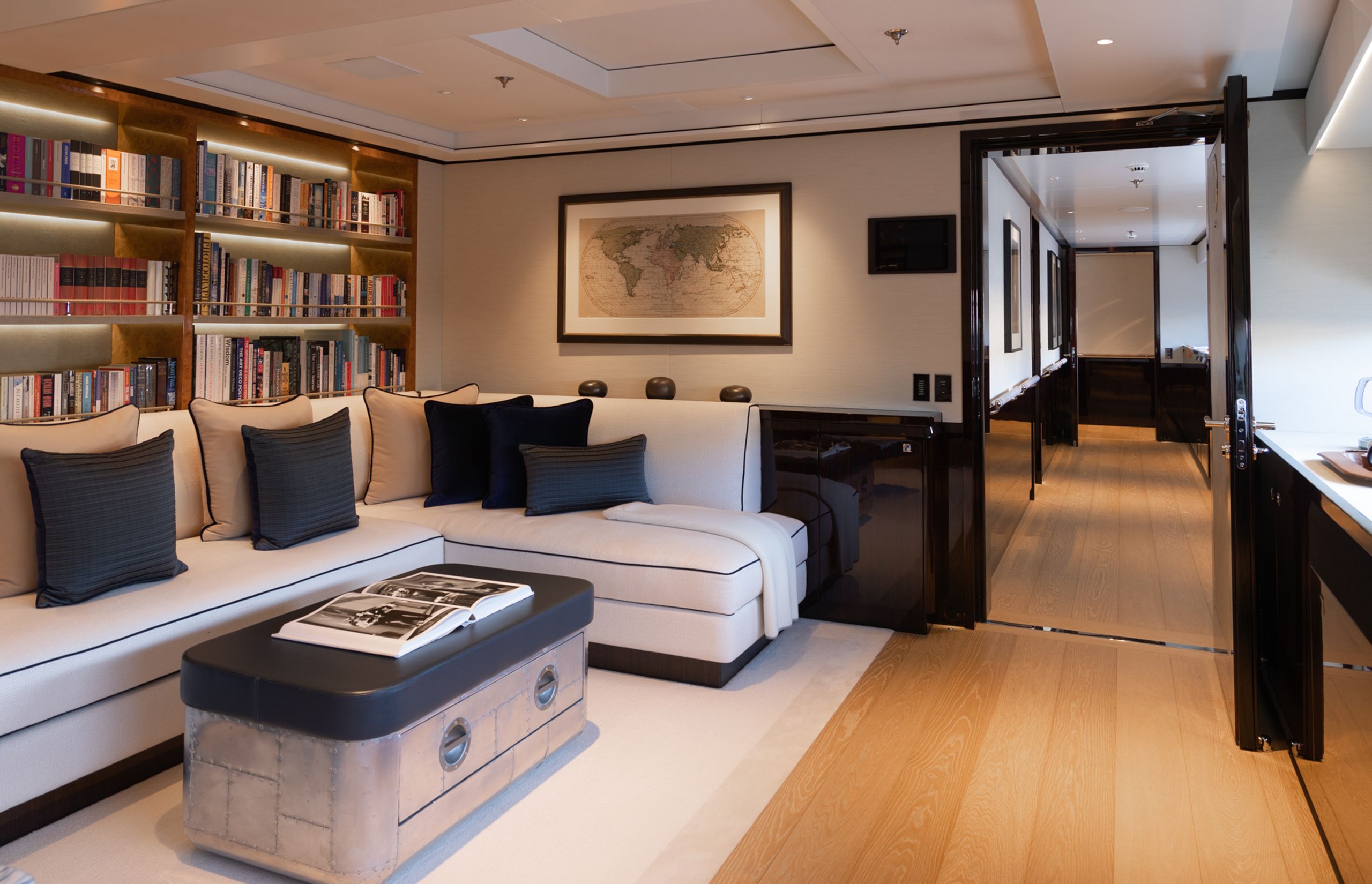
Monk developed three helm concept directions for the owner before meeting on the boat in Charleston, South Carolina, in October 2018. Since she identified three function areas of the deck – sun area forward, bar and dining in the centre and helms aft – she and Hendy realised the top would be better in three specialised sections. “I started by looking at legs for the structure. Using carbon fibre would mean we could minimise the size of the supports and a sunroof at the dining table would allow guests to look up and see the sails. I don’t like a bunch of spotlights, so we concentrated on indirect lighting in the structure. The geometry of the lines of the mainsheet to the traveller were my inspiration and designing the helms and the hardtop together would result in features that looked like they belonged together in the boat,” Monk says.
Solving the keel noise, meanwhile, took on an exhaustive engineering approach in which the owner was fully engaged, according to Doyle. “We looked at five options from adding a second lifting ram to straighten the travel angle to a totally new keel with its own box, but that would have involved massive disassembly of the owner’s stateroom. In the end, the best solution was the easiest one: we removed the keel, cut it in half, moved the lifting pin forward 375 to 400 millimetres and closed it back up. It was so simple that we almost ignored it. This also gave us the chance to replace all the keel bolts and locking pins. Its shape and 96-tonne weight remain unchanged. The boat is better than new. This is the boat living up to her potential.”
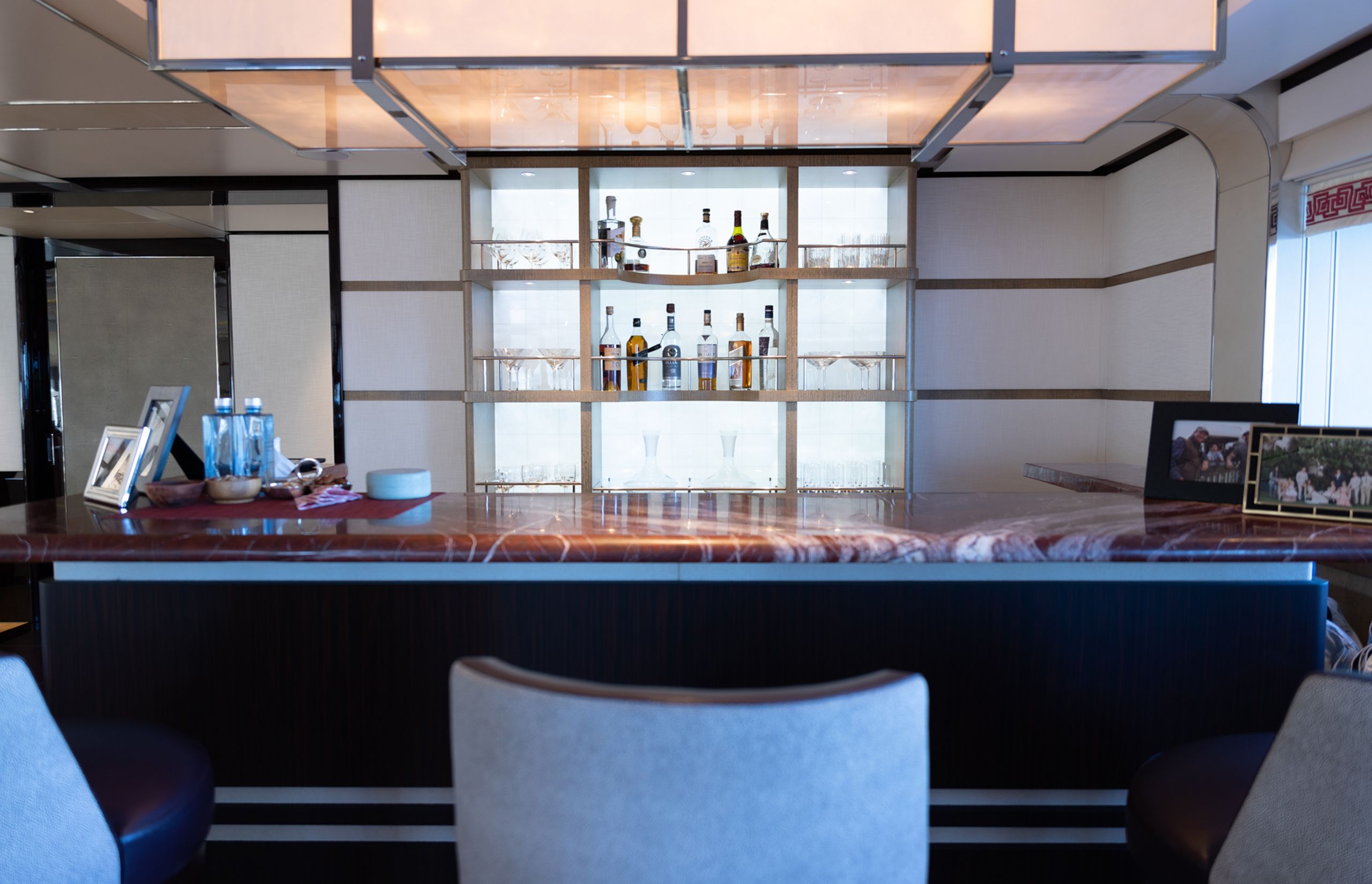
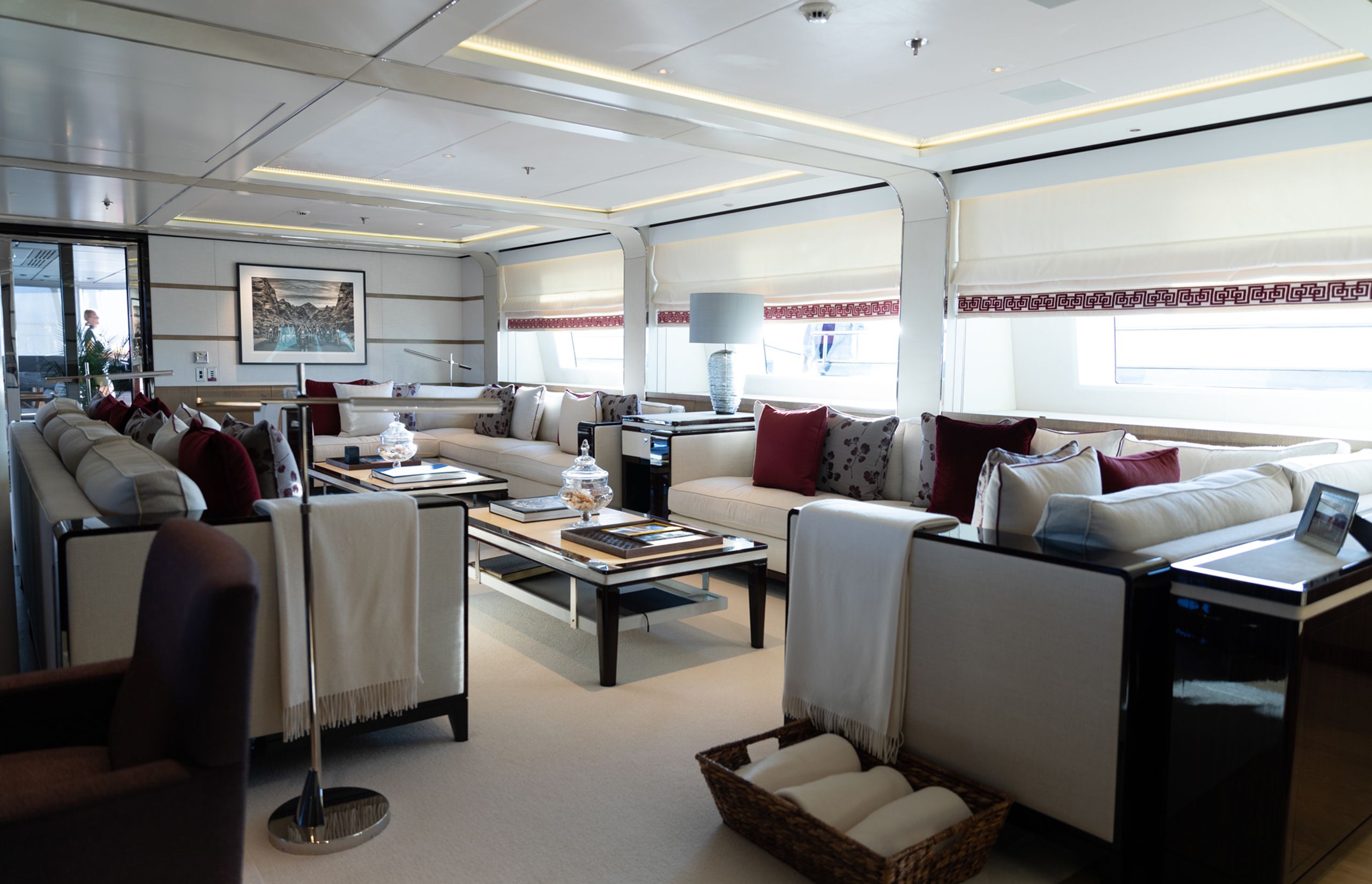
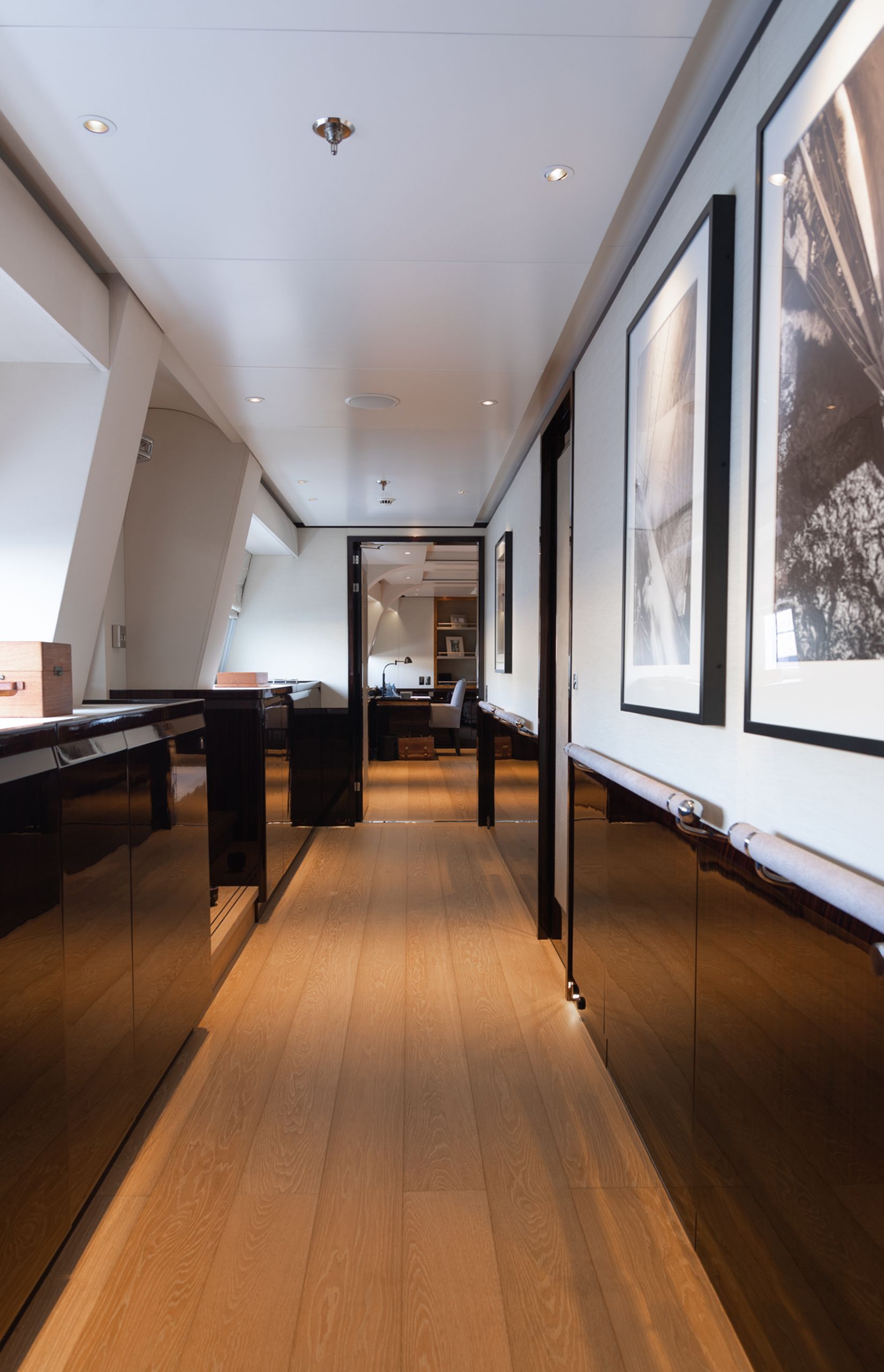
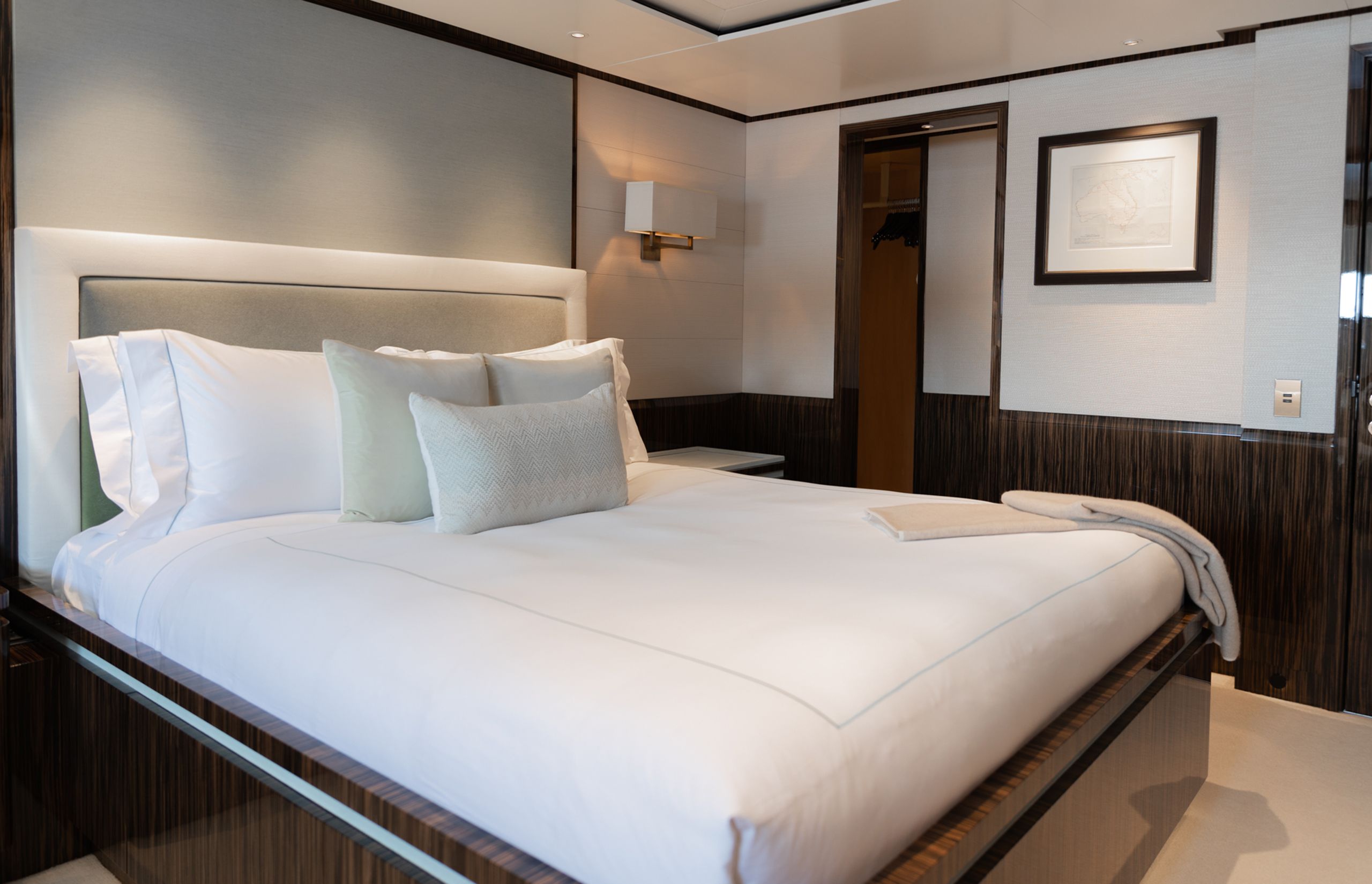
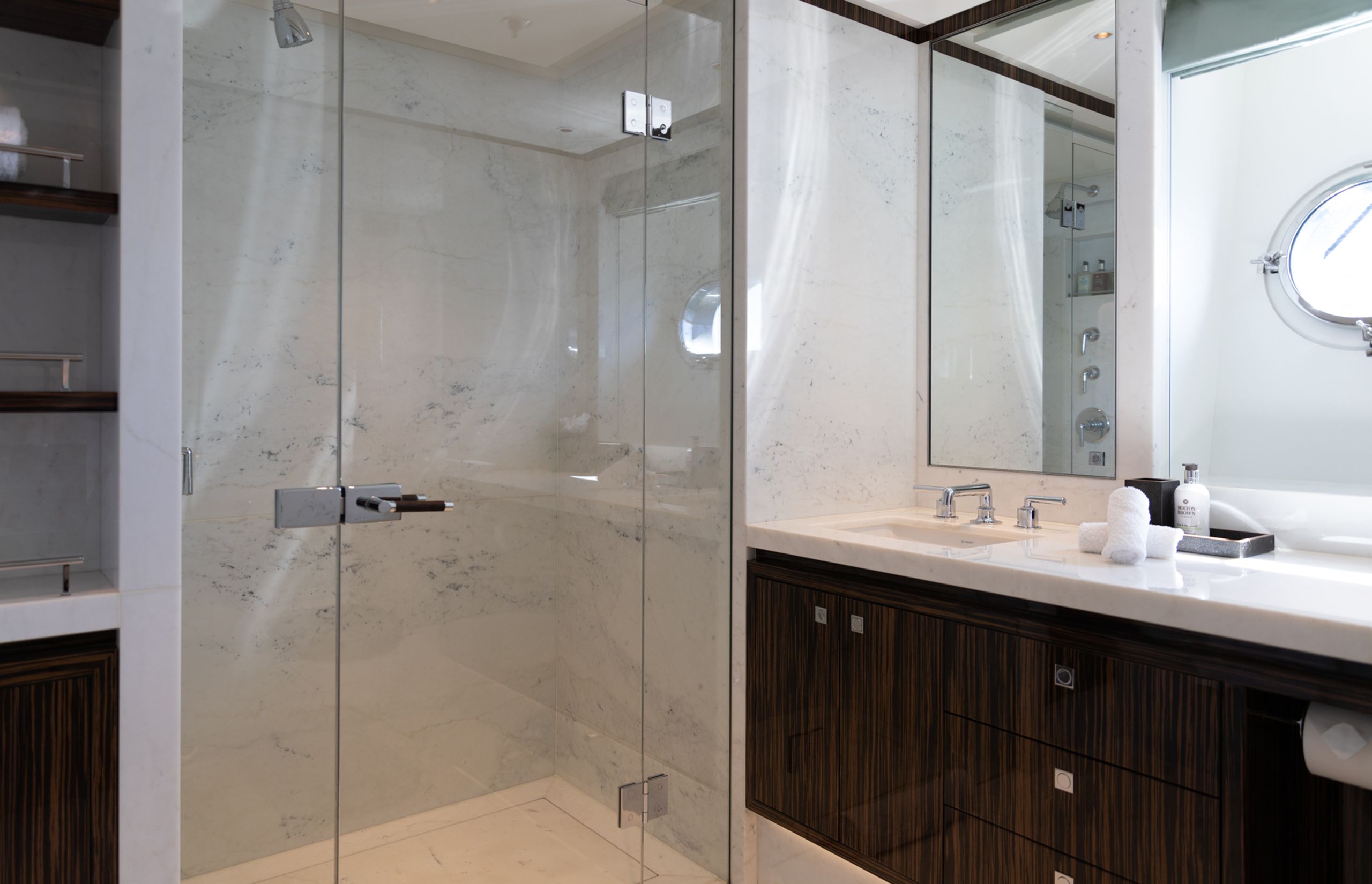

BRADLEY WENTZEL
BRADLEY WENTZEL

BRADLEY WENTZEL
BRADLEY WENTZEL

BRADLEY WENTZEL
BRADLEY WENTZEL

BRADLEY WENTZEL
BRADLEY WENTZEL

BRADLEY WENTZEL
BRADLEY WENTZEL
Top left: the dramatic new bar top was cut from a slab of precious red jasper, a stone revered by Norse warriors and Ancient Egyptians for its strength and healing properties. The red jasper tones, along with grey, gave RWD the direction of the colour scheme for new soft goods
As to the new hull colour, “The owner had seen a grey motor yacht he liked and his sportfishing boat is grey, so we zeroed in on that,” says Anderson. “The last refit saw the boot stripe painted dark blue and the crew kept a careful eye on it watching for signs of print-through in the sun. Doyle had models painted with various colour combinations while NCA made up a number of one-square-metre fibreglass panels painted in various shades to be tested for heat generation and how the substrate reacted.”
A metallic grey from AkzoNobel tested the best for heat reflectivity, with a lighter colour in the same range selected for the superstructure and the whole thing given a clear coat. “It looks sleeker now and faster,” says Lewis.
During planning, the interior was just going to be refreshed, replacing like for like, with new overheads, new floors and new marble countertops, but as these things often do, “what-ifs” took hold and RWD, which was working on a refit of Lewis’s sportfisher in Seattle, was asked to provide direction and update some materials and the colour palette of the soft goods. The latter was inspired by a spectacular piece of ancient Egyptian red jasper belonging to one of Lewis’s friends, a marble expert who lives in Rome. He offered it to Lewis if there was a way to use it on M5 and they decided it would make a fantastic bar top.
“I don’t think there’s a lot more that I could do to the boat”
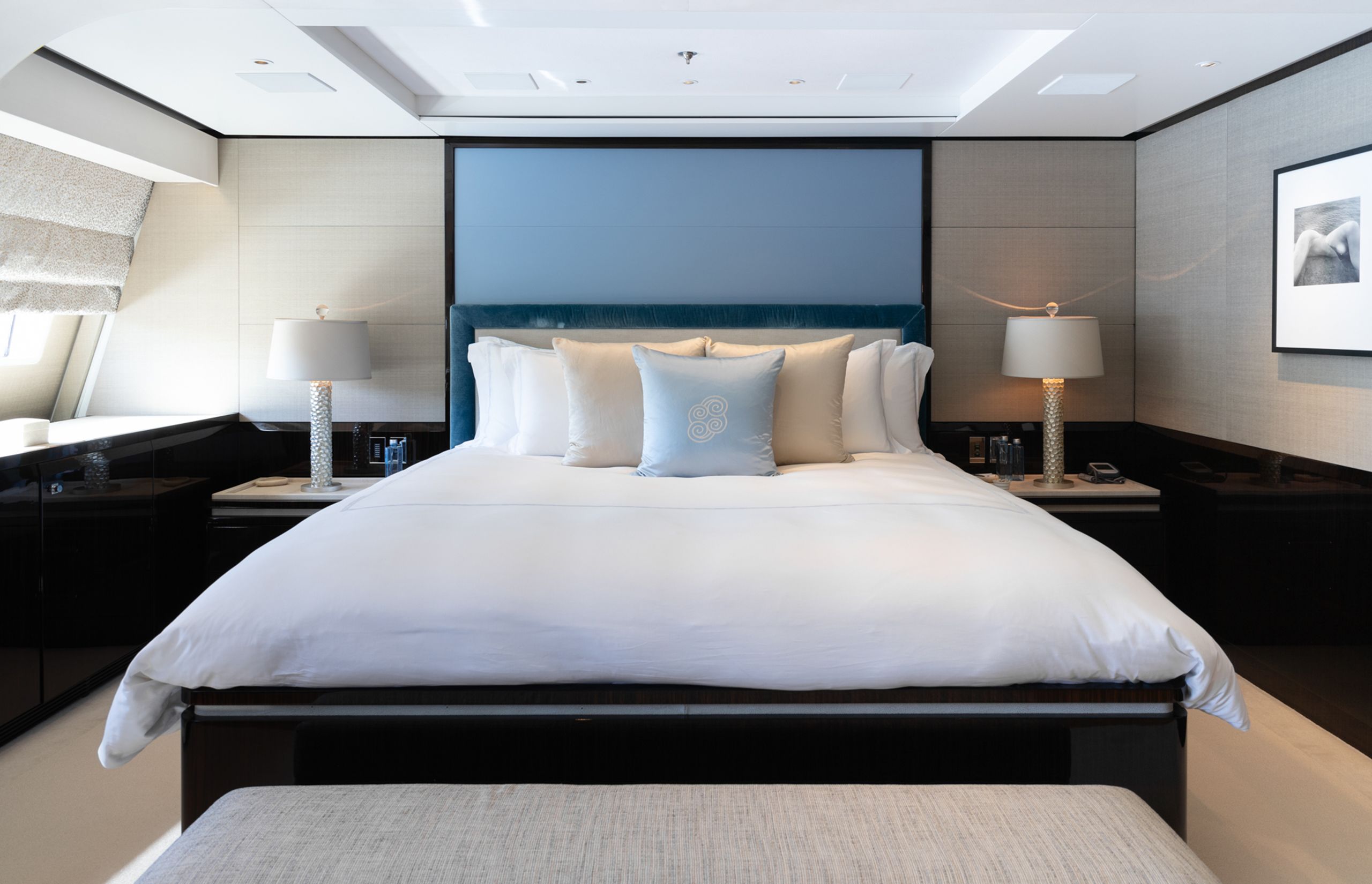
“There were eight pieces to be cut from the block to assemble into a bar top. Nobody in Carrara would cut it as jasper is the hardest stone; everyone said it would ruin their tools, or it was irreplaceable and they didn’t want to risk cracking it,” says Giulio Pennacchio, who manages NCA’s team. “All these enormous things went smoothly and here was a bar top about to ruin the job!” In desperation he stopped looking for stone cutters and started looking for sculptors, finding an artist in Forte dei Marmi to do the work. “It took 75 days to cut the stone. It is a job made with soul.”
“I don’t think there’s a lot more that I could do to the boat,” says Lewis, now nine years into its ownership. “We sail it a lot. Many of my trips are just five days, but I crossed the Pacific and Indian Oceans; those were 28 days each. This time I will be on the boat for 45 days. It feels good to do something wind powered; I make my money out of the natural-gas business, but I like the idea of my boat being powered by the wind.”
This feature is taken from the November 2020 issue of BOAT International. Get this magazine sent straight to your door, or subscribe and never miss an issue.
All of the teak decks received new grey caulking to match the yacht’s new exterior paint scheme
Three new carbon-fibre hardtops support the division of various functions of the spacious flying bridge
M5’s stern was lengthened in the 2013 refit to accommodate a carbon fibre float plane
The keel was removed, altered and replaced without dismantling the adjacent owner’s suite or office
The dramatic red jasper bar top was the colour cue for refreshing the interior decor
Increasing hydraulic power and modifying the housing allowed a big boost in thruster force without having to alter hull structure
The Hinckley tender was repainted to match the mothership
THE LONGEST YARD
Finding a refit yard for M5’s recent refit was no easy task. They sought a location with the potential for minimal weather delays and where they could both haul the boat and pull the mast. For a 78-metre boat with an 89-metre mast, options are limited – laying out M5’s mast requires space the length of a football field.
By the spring of 2018 the captains had whittled down the candidates, eliminating Palma because although it has a large skilled workforce and yards that could pull the mast, it had no facility to haul the boat. A relative unknown in Carrara, Italy, ticked all the boxes and after extensive investigation – the owner’s team visited the yard three times and the yard’s team visited the boat in the Bahamas to view the work list in person – they contracted with NCA, part of The Italian Sea Group and a sister company to Admiral Tecnomar. Its slipway and haul-out space are where Admiral builds yachts up to 85 metres. “Fortunately, it is not so hard to find cranes near Carrara,” quips Giulio Pennacchio who manages NCA’s team. By having M5 arrive in April, the yachts that had been hauled and serviced over the winter had been relaunched and there was prime space available to lay out the 27 tonnes of mast and rigging.
“They answered every question – I felt like it was a good risk going with them. I guess I probably doubled or tripled the work list as we went along and I grew more comfortable,” says Lewis.
TROUBLE AT THE TOP
“They sent pictures of everything on the flybridge and nothing looked like it was in keeping with the rest of this modern yacht,” says Adriana Monk, who was engaged by carbon fibre fabricator BM Composites to design the remodelling of the space. “The helm stations were dated and I could see what they were saying about the layout being awkward. I felt it was important to see the boat in person and take my own measurements and photos for 3D modelling. Then they pointed up at the bimini and asked Luke [Hendy, BM Composites commercial manager] and me if we could make something nice to replace this and add some wings over the helms.
Because the canvas awning fitted within the curved shape of the arch supporting the domes, it didn’t fully cover the helmsman or the monitors. “Captain Bergman was fundamental to our understanding of what they needed to make it a better environment,” says Hendy. The new consoles and the hardtops were made of carbon fibre in precise female moulds; 3D scans of existing structures were essential because measurements did not match original engineering drawings.
All pieces were constructed and finished off-site so that they could be brought to the boat for installation at just the right time, not delaying painting or re-caulking the decks. For the helm coverage, Monk and Hendy finetuned a motorised sliding section for sun and rain protection with 3D Tech, based in Palma. At the touch of a button, two angled sections slide out on each side and forward, providing 400 millimetres more coverage.

